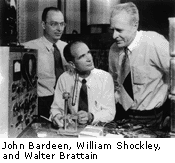|
~ Maniac's Library |
||||
The Story of the Transistor (1) Bell
Laboratories, one of the world’s largest industrial laboratories
and now part of Lucent Technologies, was But as the uses for vacuum tubes increased, so did the frustration at their limitations. Vacuum tubes were big and clumsy. They used a lot of power, they generated large amounts of heat, and they were fragile. Clearly, a better device was needed. New advances in theoretical physics and quantum mechanics suggested that a class of materials called semiconductors—materials like silicon or germanium that normally are very poor conductors of electricity—might, under the right conditions, be able to replace the vacuum tube. At Bell Labs, a young, brilliant theoretician, Bill Shockley, was selected to lead a team researching the potential of semiconductor materials. Shockley drafted Walter Brattain, an experimental physicist who could build or fix just about anything, and hired theoretical physicist, John Bardeen. Shockley filled out his team with an eclectic mix of physicists, chemists, and engineers, and they set to work to create a semiconductor amplifier.
In 1945 Shockley proposed an amplifier design in which an electric field would enhance the flow of electrons near the surface of a layer of silicon. His colleagues tried several versions of this "field effect" amplifier but without success. He assigned Bardeen and Brattain to find out why the idea didn’t work. It was a productive partnership—Bardeen, the theoretician, suggested experiments and interpreted the results, while Brattain built and ran the experiments. For two years, they did countless tests on different samples of silicon and germanium. Then in December, 1947, in a combination of brilliant theoretical insight and serendipitous accidents, Bardeen and Brattain produced the world’s first semiconductor amplifier—the point-contact transistor was born. Spurred on by this first discovery, Shockley developed an improved transistor design—the "junction" transistor. It was used throughout the 1950s and 1960’s in a variety of electronic circuits, most notably for the first transistor radios. Further refinements led to the modern "field effect" transistor, which has literally become the nerve cell of the information age. Ironically, the modern transistor operates much as Shockley proposed in 1945.
Even though Shockley, Bardeen, and Brattain shared the 1956 Nobel Prize in Physics, jealousies over proper credit for the discovery and its application tore the successful team apart. John Bardeen left Bell Labs for the University of Illinois, and later won a second Nobel Prize—the only scientist ever to win two prizes in physics—for his work in superconductivity. Brattain stayed on at Bell Labs until his retirement in the early 1960s, after which he taught physics at Whitman College in Washington. Shockley left Bell Labs to start his own semiconductor company in California. Although he was unsuccessful as a businessman, his company sowed the seeds for what became Silicon Valley. Engineers and physicists whom he brought to California went on to invent the integrated circuit, embedding transistors and other electronic parts on one tiny piece of semiconductor. These ultimately became the microchips of today, some holding millions of transistors! When the transistor was first unveiled to the public, in the spring of 1948, it got little attention, neither in the popular press nor in the scientific community. But in the 1950s it was quickly adopted for industrial and military applications, and, of course, the transistor radio. The transistor was the key to advances in technology. The transistor allowed information to be easily processed and scattered to the ends of the Earth; the miniaturization of electronics made possible human exploration of space; and the advent of the microchip ushered in the age of the PC and the internet. The three inventors could hardly have known the outcome when they made their discovery in 1947—that they were going to change the world.
|
||||

 originally
the research and development arm of the giant telephone company
American Telephone and Telegraph(AT&T). One of the first pioneering
advances of Bell Labs in the early 1900s was a practical version
of the vacuum tube. This device amplified faint telephone signals
and was the key to America’s coast-to-coast telephone system.It
also worked as a high speed on-off switch. Over the next three decades,
vacuum tubes were pressed into service for everything from home
radios to military radar. Even the first electronic computer relied
on vacuum tubes—about 18,000 of them!
originally
the research and development arm of the giant telephone company
American Telephone and Telegraph(AT&T). One of the first pioneering
advances of Bell Labs in the early 1900s was a practical version
of the vacuum tube. This device amplified faint telephone signals
and was the key to America’s coast-to-coast telephone system.It
also worked as a high speed on-off switch. Over the next three decades,
vacuum tubes were pressed into service for everything from home
radios to military radar. Even the first electronic computer relied
on vacuum tubes—about 18,000 of them!
